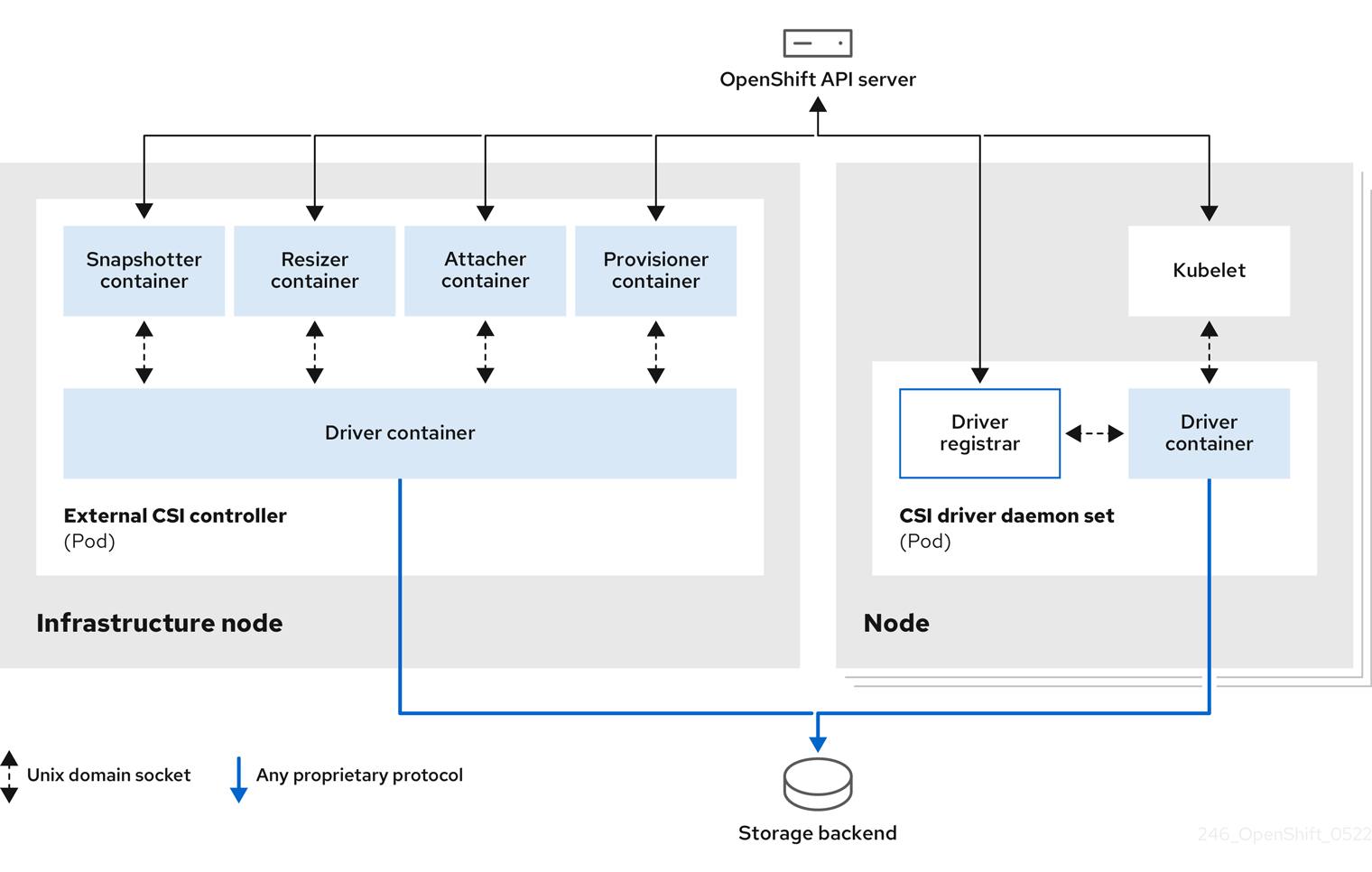第 5 章 使用 Container Storage Interface (CSI)
5.1. 配置 CSI 卷
容器存储接口 (CSI) 允许 OpenShift Container Platform 使用支持 CSI 接口的存储后端提供的持久性存储。
OpenShift Container Platform 4.9 支持 CSI 规格的版本 1.5.0。
5.1.1. CSI 架构
CSI 驱动程序通常由容器镜像提供。这些容器不了解其运行的 OpenShift Container Platform。要在 OpenShift Container Platform 中使用与 CSI 兼容的存储后端,集群管理员必须部署几个组件,作为 OpenShift Container Platform 和存储驱动程序间的桥接。
下图提供了在 OpenShift Container Platform 集群中以 pod 运行的组件的概述。

对于不同的存储后端,可以运行多个 CSI 驱动程序。每个驱动程序需要其自身的外部控制器部署,以及带驱动程序和 CSI 注册器的守护进程集。
5.1.1.1. 外部 CSI 控制器
外部 CSI 控制器是一个部署,它部署带有以下五个容器的一个或多个 pod:
-
snapshotter 容器监视
VolumeSnapshot和VolumeSnapshotContent对象,并负责创建和删除VolumeSnapshotContent对象。 -
resizer 容器是一个 sidecar 容器,它会在 PersistentVolumeClaim 对象中监视
PersistentVolumeClaim更新,并在对PersistentVolumeClaim对象请求更多存储时针对 CSI 端点触发ControllerExpandVolume操作。 -
一个外部 CSI attacher 容器,它会将 OpenShift Container Platform 的
attach和detach调用转换为相关的 CSI 驱动程序的ControllerPublish和ControllerUnpublish调用。 -
一个外部 CSI 置备程序容器,它可将 OpenShift Container Platform 的
provision和delete调用转换为相应的 CSI 驱动程序的CreateVolume和DeleteVolume调用。 - 一个 CSI 驱动程序容器
CSI attacher 和 CSI provisioner 容器使用 UNIX 域套接字与 CSI 驱动程序容器进行交互,确保没有 CSI 通讯会离开 pod。从 pod 以外无法访问 CSI 驱动程序。
attach、 detach、 provision和 delete 操作通常需要 CSI 驱动程序在存储后端使用凭证。在 infrastructure 节点上运行 CSI controller pod,因此即使在一个计算节点上发生严重的安全破坏时,凭据也不会暴露给用户进程。
当不支持第三方的 attach 或 detach 操作时,还需要为 CSI 驱动程序运行外部的附加器。外部附加器不会向 CSI 驱动程序发出任何 ControllerPublish 或 ControllerUnpublish 操作。然而,它仍必须运行方可实现所需的 OpenShift Container Platform attachment API。
5.1.1.2. CSI 驱动程序守护进程集
CSI 驱动程序守护进程集在每个节点上运行一个 pod,它允许 OpenShift Container Platform 挂载 CSI 驱动程序提供的存储,并使用它作为持久性卷 (PV) 的用户负载 (pod) 。安装了 CSI 驱动程序的 pod 包含以下容器:
-
一个 CSI 驱动程序注册器,它会在节点上运行的
openshift-node服务中注册 CSI 驱动程序。在节点上运行的openshift-node进程然后使用节点上可用的 UNIX 域套接字直接连接到 CSI 驱动程序。 - 一个 CSI 驱动程序。
在节点上部署的 CSI 驱动程序应该在存储后端中拥有尽量少的凭证。OpenShift Container Platform 只使用节点插件的 CSI 调用集合,如NodePublish/NodeUnpublish 和 NodeStage/NodeUnstage(如果这些调用已被实现)。
5.1.2. OpenShift Container Platform 支持的 CSI 驱动程序
OpenShift Container Platform 默认安装某些 CSI 驱动程序,为用户提供树状卷插件无法进行的存储选项。
要创建挂载到这些支持的存储资产中的 CSI 置备的持久性卷,OpenShift Container Platform 会默认安装必要的 CSI 驱动程序 Operator、CSI 驱动程序和所需的存储类。如需有关 Operator 和驱动程序的默认命名空间的更多信息,请参阅特定 CSI Driver Operator 的文档。
下表描述了 OpenShift Container Platform 安装的 CSI 驱动程序及其支持的 CSI 功能,如卷快照、克隆和调整大小。
| CSI 驱动程序 | CSI 卷快照 | CSI 克隆 | CSI 调整大小 |
|---|---|---|---|
| AWS EBS |
✅ |
- |
✅ |
| AWS EFS(技术预览) |
- |
- |
- |
| Google Cloud Platform(GCP)持久磁盘(PD) |
✅ |
- |
✅ |
| Microsoft Azure Disk(技术预览) |
✅ |
✅ |
✅ |
| Microsoft Azure Stack Hub |
✅ |
✅ |
✅ |
| OpenStack Cinder |
✅ |
✅ |
✅ |
| OpenShift Container Storage |
✅ |
✅ |
✅ |
| OpenStack Manila |
✅ |
- |
- |
| Red Hat Virtualization(oVirt) |
- |
- |
✅ |
| VMware vSphere(技术预览) |
- |
- |
- |
如果上表中没有列出您的 CSI 驱动程序,则需要按照 CSI 存储厂商提供的安装说明方可使用其支持的 CSI 功能。
5.1.3. 动态置备
动态置备持久性存储取决于 CSI 驱动程序和底层存储后端的功能。CSI 驱动的供应商应该提供了在 OpenShift Container Platform 中创建存储类及进行配置的参数文档。
创建的存储类可以被配置为启用动态置备。
流程
创建一个默认存储类,以保证所有不需要特殊存储类的 PVC 由安装的 CSI 驱动程序来置备。
# oc create -f - << EOF apiVersion: storage.k8s.io/v1 kind: StorageClass metadata: name: <storage-class> 1 annotations: storageclass.kubernetes.io/is-default-class: "true" provisioner: <provisioner-name> 2 parameters: EOF
5.1.4. 使用 CSI 驱动程序示例
以下示例在没有对该模板进行任何修改的情况下安装了一个默认的 MySQL 模板,。
先决条件
- CSI 驱动程序已被部署。
- 为动态置备创建了存储类。
流程
创建 MySQL 模板:
# oc new-app mysql-persistent
输出示例
--> Deploying template "openshift/mysql-persistent" to project default ...
# oc get pvc
输出示例
NAME STATUS VOLUME CAPACITY ACCESS MODES STORAGECLASS AGE mysql Bound kubernetes-dynamic-pv-3271ffcb4e1811e8 1Gi RWO cinder 3s